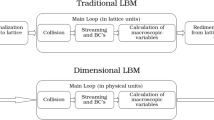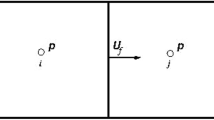Abstract
This paper presents an unresolved computational fluid dynamic–discrete element method (CFD–DEM) model for the simulation of flows mixing fluid and grains. The grains trajectories are solved at a fine scale using a discrete element method. It provides the velocities and the trajectories of the grains with an accuracy that is needed to describe microscopic phenomena like clogging in pipe happening in these flows. Solved at a coarse scale using the finite element method, the fluid motion is deduced from a mean continuous representation of the fluid phase giving computational performance and keeping variables evolutions that are of interest for a lot of simulation processes. The key point of this method lays in the coupling of the two different representation scales. An empirical drag formula for monodisperse granular media parametrises the transfer of momentum between the phases. Applying this model to the well-known problem of suspension drops provides validation and insight in this kind of methodology. Simulations in which inertia is non-negligible are achieved to prove the generality and adaptability of the unresolved CFD–DEM model compared to other models.










Similar content being viewed by others
References
Abade G, Cunha F (2007) Computer simulation of particle aggregates during sedimentation. Comput Methods Appl Mech Eng 196(45):4597–4612
Adachi K, Kiriyama S, Yoshioka N (1978) The behavior of a swarm of particles moving in a viscous fluid. Chem Eng Sci 733:115–121
Alart P, Curnier A (1991) A mixed formulation for frictional contact problems Prone to Newton like solution methods. Comput Methods Appl Mech Eng 92:353–375. https://doi.org/10.1016/0045-7825(91)90022-X
Anderson T, Jackson R (1968) A fluid mechanical description of fluidized beds: stability of the uniform state of fluidization. I&EC Fundam 7:12–21
Babuska I (1973) The finite element method with lagrangian multipliers. Numer Math 20(3):179–192
Batchelor GK (1967) An introduction to fluid dynamics. Cambridge University Press, Cambridge
Batchelor GK (1972) Sedimentation in a dilute dispersion of spheres. J Fluid Mech 52(2):245–268. https://doi.org/10.1017/S0022112072001399
Bosse T, Kleiser L, Härtel C, Meiburg E (2005) Numerical simulation of finite Reynolds number suspension drops settling under gravity. Phys Fluids 17(3):037101
Bouillard J, Gidaspow D, Lyczkowski R (1991) Hydrodynamics of fluidization: fast-bubble simulation in a two-dimensional fluidized bed. Powder Technol 66(2):107–118
Brezzi F, Douglas J (1988) Stabilized mixed method for Stokes problem. Numer Math 53:225–235
Brezzi F, Pitkaranta J (1984) On the stabilization of the finite element approximations of the Stokes equations. In: Hackbush W (ed) Efficient solution of elliptic systems, vol 10. Vieweg, Braunschweig, pp 11–19
Brinkman HC (1947) A calculation of the viscous force exerted by a flowing fluid on a dense swarm of particles. Appl Sci Res A1:27–34
Bülow F, Nirschl H, Dörfler W (2015) On the settling behaviour of polydisperse particle clouds in viscous fluids. Eur J Mech B/Fluids 50:19–26
Chu K, Wang B, Yu A, Vince A (2009) CFD–DEM modelling of multiphase flow in dense medium cyclones. Powder Technol 193(3):235–247. https://doi.org/10.1016/j.powtec.2009.03.015 (Special issue: Discrete element methods: the 4th international conference on discrete element methodsthe 4th international conference on discrete element methods, Brisbane, August 2007)
Chu K, Yu A (2008) Numerical simulation of complex particle-fluid flows. Powder Technol 179(3):104–114. https://doi.org/10.1016/j.powtec.2007.06.017 (WCPT5Papers presented at the 5th world conference of particle technology (WCPT5), Orlando, Florida, April 23–27 20065th world conference of particle technology (WCPT5))
Cundall PA, Strack ODL (1979) A discrete numerical model for granular assemblies. Géotechnique 29(1):47–65
DallaValle JM, Klemin A (1943) Micromeritics: the technology of the particles. Pitman Publishing Corporation, New York
Di Renzo A, Di Maio FP (2007) Homogeneous and bubbling fluidization regimes in dem-cfd simulations: hydrodynamic stability of gas and liquid fluidized beds. Chem Eng Sci 62(1–2):116–130
Dubois F, Acary V, Jean M (2018) The contact dynamics method: a nonsmooth story. Comptes Rendus Mécanique 346(3):247–262. https://doi.org/10.1016/j.crme.2017.12.009
Ergun S (1952) Fluid flow through packed columns. Chem Eng Prog 48:89–94
Felice RD (1994) The voidage function for fluid–particle interaction systems. Int J Multiph Flow 20(1):153–159
Feng Y, Yu A (2004) Assessment of model formulations in the discrete particle simulation of gas–solid flow. Ind Eng Chem Res 43(26):8378–8390
Galindo-Torres S (2013) A coupled discrete element lattice boltzmann method for the simulation of fluid–solid interaction with particles of general shapes. Comput Methods Appl Mech Eng 265:107–119
Geuzaine C, Remacle JF (2009) Gmsh: a 3-d finite element mesh generator with built-in pre-and post-processing facilities. Int J Numer Methods Eng 79(11):1309–1331
Gidaspow D (2012) Multiphase flow and fluidization: continuum and kinetic theory descriptions. Academic Press, London
Gupta P (2015) Verification and validation of a DEM-CFD model and multiscale modelling of cohesive fluidization regimes. Ph.D. thesis, The University of Edinburgh
Ho T, Phan-Thien N, Khoo B (2016) Destabilization of clouds of monodisperse and polydisperse particles falling in a quiescent and viscous fluid. Phys Fluids 28(6):063305
Hoomans BPB, Kuipers JAM, Briels WJ, van Swaaij WPM (1996) Discrete particle simulation of bubble and slug formation in a two-dimensional gas-fluidised bed: a hard-sphere approach. Chem Eng Sci 51(1):99–118
Hu HH (1996) Direct simulation of flows of solid–liquid mixture. Int J Multiph Flow 22(2):335–352
Hughes TJR, Franca LP (1986) A new finite element formulation for computational fluid dynamics: V. Circumeventing the Babuska–Brezzi condition: a stable petrov-galerking formulation of the stokes problem accomodating equal-order interpolations. Comput Methods Appl Mech Eng 59:85–99
Jackson R (1997) Locally averaged equations of motion for a mixture of identical spherical particles and a newtonian fluid. Chem Eng Sci 52(15):2457–2469. https://doi.org/10.1016/S0009-2509(97)00065-1 (Mathematical modelling of chemical and biochemical processes)
Jean M (1999) The non-smooth contact dynamics method. Comput Methods Appl Mech Eng 177(3–4):235–257
Jean M, Moreau J (1992) Unilaterality and dry friction in the dynamics of rigid body collections. In: Proceedings of contact mechanics international symposium, vol 1, pp 31–48
Jourdan F, Alart P, Jean M (1998) A Gauss–Seidel like algorithm to solve frictional contact problems. Comput Methods Appl Mech Eng 155:31–47. https://doi.org/10.1016/S0045-7825(97)00137-0
Kafui K, Thornton C, Adams M (2002) Discrete particle-continuum fluid modelling of gas–solid fluidised beds. Chem Eng Sci 57(13):2395–2410
Ladyshenskaya OA (1969) The mathematical theory of viscous incompressible flow. Gordon and Breach, New York
Lamb H (1932) Hydrodynamics. Cambridge University Press, Cambridge
Landau LD, Lifshitz EM (1987) Course of theoretical physics. In: Fluid mechanics, vol 6, 2nd edn. Pergamon Press, pp. 336–343
Li J, Kuipers JAM (2003) Gas–particle interactions in dense gas-fluidized beds. Chem Eng Sci 58(3–6):711–718
Lin Y, Tan JH, Phan-Thien N, Khoo BC (2017) Settling of particle-suspension drops at low to moderate Reynolds numbers. Eur J Mech B/Fluids 61:72–76
Machu G, Meile W, Nitsche LC, Schaflinger U (2001) Coalescence, torus formation and break-up of sedimenting clouds: experiments and computer simulations. J Fluid Mech 447:299–336
McNamara S, Young WR (1992) Inelastic collapse and clumping in a one-dimensional granular medium. Phys Fluids A Fluid Dyn 4(3):496–504
Metzger B, Nicolas M, Guazzelli E (2007) Falling clouds of particles in viscous fluids. J Fluid Mech 580:283–301
Mylyk A, Meile W, Brenn G, Ekiel-Jeżewska M (2011) Break-up of suspension drops settling under gravity in a viscous fluid close to a vertical wall. Phys Fluids 23(6):063302
Nguyen NQ, Ladd A (2002) Lubrication corrections for Lattice–Boltzmann simulations of particle suspensions. Phys Rev E 66(4):046708
Nitsche JM, Batchelor GK (1997) Break-up of a falling cloud containing dispersed particles. J Fluid Mech 340:161–175
Patankar S (1980) Numerical heat transfer and fluid flow. CRC Press, Boca Raton
Peskin CS (2002) The immersed boundary method. Acta Numer 11:479–517
Pignatel F, Nicolas M, Guazzelli E (2011) A falling cloud of particles at a small but finite Reynolds number. J Fluid Mech 671:34–51
Pritchett J, Blake T, Garg S (1978) A numerical model of gas fluidized beds. In: AIChE symposium series, vol 74, p 134
Renouf M, Dubois F, Alart P (2004) A parallel version of the non smooth contact dynamics algorithm applied to the simulation of granular media. J Comput Appl Math 168:375–382. https://doi.org/10.1016/j.cam.2003.05.019 (Selected papers from the second international conference on advanced computational methods in engineering (ACOMEN 2002))
Richardson J, Zaki W (1954) The sedimentation of a suspension of uniform spheres under conditions of viscous flow. Chem Eng Sci 3(2):65–73. https://doi.org/10.1016/0009-2509(54)85015-9
Rzadkiewicz SA, Mariotti C, Heinrich P (1996) Modelling of submarines landslides and generated water waves. Phys Chem Earth 21(1–2):1–12
Sanchez PJ, Sonzogni VE, Huespe AE (2008) Study of a stabilized mixed finite element with emphasis on its numerical performance for strain localization problems. Int J Numer Methods Biomed Eng 24(4):297–320
Subramanian G, Koch DL (2008) Evolution of clusters of sedimenting low-Reynolds-number particles with oseen interactions. J Fluid Mech 603:63–100
Taghipour F, Ellis N, Wong C (2005) Experimental and computational study of gas–solid fluidized bed hydrodynamics. Chem Eng Sci 60(24):6857–6867
Tezduyar TE (1991) Stabilized finite element formulations for incompressible flow computations. Adv Appl Mech 28:1–44
Tezduyar TE, Mittal S, Ray S, Shih R (1992) Incompressible flow computations with stabilized bilinear and linear equal-order-interpolation velocity-pressure elements. Comput Methods Appl Mech Eng 95(2):221–242
Tsuji Y, Kawaguchi T, Tanaka T (1993) Discrete particle simulation of two dimensional fluidized bed. Powder Technol 77(1):79–87
Tsuji Y, Tanaka T, Ishida T (1992) Lagrangian numerical simulation of plug flow of cohesionless particles in a horizontal pipe. Powder Technol 71(3):239–250. https://doi.org/10.1016/0032-5910(92)88030-L
van Wachem B, Almstedt A (2003) Methods for multiphase computational fluid dynamics. Chem Eng J 96(13):81–98. https://doi.org/10.1016/j.cej.2003.08.025 (Festschrift Prof. Cor M. van den Bleek)
Wen CY, Yu HY (1966) Chemical engineering progress symposium series. Mech Fluid 62:100–111
Xu BH, Yu AB (1997) Numerical simulation of the gas–solid flow in a fluidized bed by combining discrete particle method with computational fluid dynamics. Chem Eng Sci 52(16):2785–2809
Yu A, Xu B (2003) Particle-scale modelling of gas–solid flow in fluidisation. J Chem Technol Biotechnol 78(2–3):111–121
Zhang J, Fan LS, Zhu C, Pfeffer R, Qi D (1999) Dynamic behaviour of collision of elastic spheres in viscous fluids. Powder Technol 106(1–2):98–109
Zhang P, Galindo-Torres S, Tang H, Jin G, Scheuermann A, Li L (2017) An efficient discrete element lattice Boltzmann model for simulation of particle–fluid, particle–particle interactions. Comput Fluids 147:63–71
Zhong W, Yu A, Zhou G, Xie J, Zhang H (2016) CFD simulation of dense particulate reaction system: approaches, recent advances and applications. Chem Eng Sci 140:16–43. https://doi.org/10.1016/j.ces.2015.09.035
Zhu HP, Zhou ZY, Yang RY, Yu AB (2007) Discrete particle simulation of particulate system: theoretical developments. Chem Eng Sci 62(13):3378–3396
Acknowledgements
Matthieu Constant is a Research Fellow with the Belgium Fund for Research in Industry and Agriculture (FRIA).
Funding
This study was funded by the F.R.S.-FNRS through a FRIA Grant (29627518).
Author information
Authors and Affiliations
Corresponding author
Ethics declarations
Conflict of interest
The authors declare that they have no conflict of interest.
Additional information
Publisher's Note
Springer Nature remains neutral with regard to jurisdictional claims in published maps and institutional affiliations.
Rights and permissions
About this article
Cite this article
Constant, M., Dubois, F., Lambrechts, J. et al. Implementation of an unresolved stabilised FEM–DEM model to solve immersed granular flows. Comp. Part. Mech. 6, 213–226 (2019). https://doi.org/10.1007/s40571-018-0209-4
Received:
Revised:
Accepted:
Published:
Issue Date:
DOI: https://doi.org/10.1007/s40571-018-0209-4




